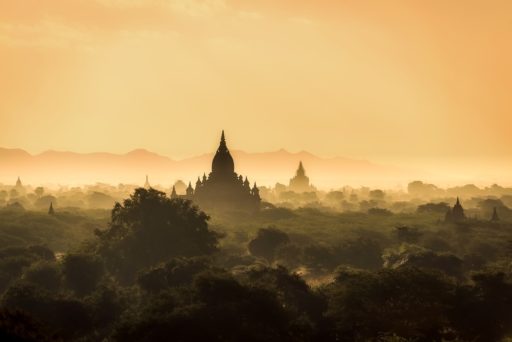By Zun Nwe Tun Oo

“Ghaw luh ghay, tharamu,” said the students as soon as they saw me walking towards them.
“Wor luh ghay,” I replied. One can readily know from my different accent that I was not speaking my mother tongue. I was visiting Mae La Refugee camp which situated on the border of Myanmar and Thailand.
There are 135 different ethnic groups in Myanmar and each group has its own dialect and tradition. Among them, the majority Bamar people takes up about two thirds of the total population. Most of the ethnic minorities reside on the edges of the country. As the former military regime fostered Bamarnization policies, tensions between ethnic minorities and Bamar people emerged.
I am a Bamar Shan. Both of my grandpas are Shan ethnic people and my grandmas are Bamars. I was born in Mandalay, another Bamar dominated city in the center of Myanmar. As I grew up in Mandalay and attended a state school, I could not speak and never thought of learning Shan dialect. Neither could my parents speak Shan because my grandpas believed that there is no use of teaching their kids the dialect as they were trying to camouflage themselves in the Bamar society.
Many ethnic minorities become Internally Displaced Persons (IDPs) due to the regime’s hideous human right abuses, confiscation of lands and exploitation of resources. Many more sought refuge in the Refugees Camps in the neighboring countries. In Thailand, there are nine refugee camps where about 130,000 refugees call home. Among them, Mae La is the biggest camp with the highest population, most of them are Karen.
My family moved to Mae La in early 2007 and decided to send me to a local Karen missionary school. The very first day in the school was not as smooth as I had anticipated. I was stupefied when I suddenly encountered with the situation of everyone around me speaking in a language that I do not understand. There were extremely few number of students and teachers who understand Burmese. As time passed by, I became oblivious to my surrounding as if I was deaf and mute. There was a thin air that divided me from the rest of the class. It became clear when a kid from Grade 3 pointed at me and yelled that I am one of those Bamars who killed people and everyone was sneering at me.
That was the very first time I learned how Bamar people are perceived by ethnic minorities who had been suppressed for their life-time. Never had I ever heard a dialect before I came to Mae La. My family used to visit popular tourist destinations in various states of Myanmar. All the ethnic people who live in these areas speak purportedly only Burmese and are very welcoming towards Bamar tourists. The reason behind is because the regime had monopolized all these important destinations and tried to give an impression that all Burmese speak solely Burmese. Thus, speaking Burmese becomes the most important criterion for living in a big city. All the other non-Burmese speaking ethnic minorities were chased out of the country and left in the refugee camps as if they do not belong to Myanmar.
The tension was relieved to a great extent after Saffron Revolution in September 2007 as many Bamar politicians from Yangon fled to the camp for fear of being prosecuted by the regime. Locals learned that the Bamars do not equate to the regime and the ones who actually destroyed their villages and families were not Bamars but the government. The government just used the term ‘Bamar military’ in disguise of their true nature of hideous despotism and sought the protection of innocent complicity of Bamar people. Indeed, whoever goes against the regime, including Bamar, is subject to the regime’s suppression.
The situation has further improved when Thein Sein’s quasi civilian government called for cease-fire talks, ending the six decade long armed conflict with Karen National Union (KNU). As soon as cease-fire talks were initiated in Myanmar, Burmese classes were added to the curriculum of high schools in the camps. However, there is a lack of competent teachers who can teach Burmese. Therefore, although the students have a basic knowledge of Burmese, it is still quite impossible for them to integrate into Burmese education system, where all the subjects are taught in advance Burmese. Moreover, majority of the students are still reluctant to learn and speak Burmese.
Since the political situation in Burma has somewhat turned to brighter side, there are a lot of negotiations between Thai and Myanmar authorities on repatriation of refugees. Accordingly, the refugees have voiced their concerns over the education of their children.
“There are fourteen Primary Schools, four Middle Schools, eight High Schools and six Post Ten Schools (Pre-College) in Mae La camp,” said Naw Paw Dee Sai, the education coordinator of the Mae La Refugee Camp. “The students in the Primary, Middle and High Schools have to take Burmese classes but they are quite reluctant to go to Burmese classes and I don’t think those classes are very useful. Even I, as you see, cannot speak Burmese very well,” said she in Karen. “The problem is the education in the camps is not recognized neither by Thai nor Myanmar authorities.”
The education system in the camp is coordinated by the Karen Refugee Committee Education Entity (KRCEE) along with NGOs and CBOs outside the camp. Thus, neither Thai nor Myanmar recognize any certificate awarded by the schools in the camp. The Myanmar government recently allowed the migrant students in Mae Sod to take matriculation exam. The problem with the camp education is that the curriculum is absolutely different and the student will not be able to fit in the Burmese curriculum.
The problem is further aggravated when the Thai government prohibit refugees to leave the camp for any reason. Once a refugee come out of the camp, he becomes an illegal migrant and shall be arrested accordingly. Consequently, a lot of talented and hardworking teenagers lost their hope to pursue tertiary education. Thus, many students have to find a job in the camp. Some go elsewhere in Thailand to work illegally and a few people end up being alcoholics or drug addicts as they have lost their hope and future.
Only handful of students are lucky enough to be selected by the College Preparation Courses outside the camps, such as Minmahaw Higher Education Program (MHEP) in Mae Sod or Beam Education in Chiang Mai. These programs are designed to prepare students intensively for university entrance application. Once a student is selected by these programs, they will be have a chance to apply for universities in Thailand and Hong Kong and the schools help their students to get a passport and visa. There are hundreds of students applying for these programs but less than ten students are selected every year.
John is in his early twenties and one of those who are expecting to be selected by Education Programs outside the camp. He has graduated from Eden Valley Academy, a missionary school in the camp last year. “I chose to come to the camp because I learned that I can get better education here,” said John. I have to memorize everything in Burmese in the state school. The problem is I don’t understand Burmese very well. Here, we can learn in our own dialect, Karen. I heard some of my friends in Myanmar are already in the universities. I do not regret for my choice because I know I am a lot more educated than those in the universities. Even if the authorities force me to go back, I will choose not to go back. I will find a job in Thailand,” he continued.
Dingo is another talented youth with a spirit of adventure and travelling. He was only 11 years old when he came to the camp. He engaged himself in English self-study and later was accepted by Anglican Language and Computer Centre (ALCC) in the camp. He was selected by Australian Catholic University (ACU), an Education Program in Mae Sod, in 2013. “Life is tough here but I will go forward without giving up. I am looking forward to work in an NGO after I graduate. The education in the camp is a lot better than in Myanmar,” said he. He is now anticipating to attend a university in Hong Kong.
Things are changing rapidly in Myanmar. Sooner or later, all these refugees will go back to Myanmar and start a new life. However, the objective of this decades-long-battle is not to integrate all these ethnic minorities into the mainstream Bamar society but to achieve a free society where diversity is recognized. It is still a very long way to go to achieve this ultimate aim. Life in a refugee camp is tough, but refugees do not give up. We all live with a hope that one day we will all reunite with our families. We all look forward the day when each individual in the country can live with dignity and talk his own dialect proudly.


